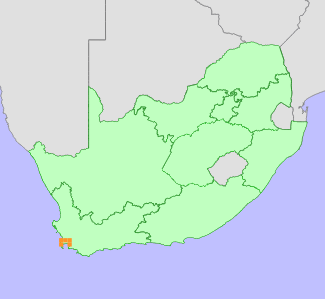|
Scientific Name | Oxalis minuta Thunb. |
Higher Classification | Dicotyledons |
Family | OXALIDACEAE |
Synonyms | Oxalis littoralis Eckl. & Zeyh., Oxalis minuta Thunb. var. major Sond., Oxalis pratensis Eckl. & Zeyh. |
National Status |
Status and Criteria | Endangered B1ab(ii,iii,v)+2ab(ii,iii,v) |
Assessment Date | 2020/10/20 |
Assessor(s) | H. Mtshali & K.C. Oberlander |
Justification | This species is endemic to the Western Cape and has a restricted distribution range, with an extent of occurrence (EOO) of 1059 km² and an area of occupancy (AOO) of 52 km², between 11 and 13 locations remain. The population is severely fragmented as remaining subpopulations occur on small remnant fragments and more than half have low numbers of mature individuals. This species has lost the majority of its habitat due to agriculture and urban development. Habitat quality at remaining locations continues to decline due to alien plant invasion and overgrazing. It therefore qualifies for listing as Endangered under criterion B. |
Distribution |
Endemism | South African endemic |
Provincial distribution | Western Cape |
Range | This species is endemic to the Western Cape Province of South Africa, where it occurs from Paarl to the Cape Peninsula. |
Habitat and Ecology |
Major system | Terrestrial |
Major habitats | Fynbos |
Description | It is usually found in damp places, at low altitudes of 50-200 m. |
Threats |
| The majority of this species' habitat has been lost to crop cultivation and urban development in the past. The remaining fragments continue to decline due to ongoing habitat degradation by alien invasive plants and livestock overgrazing. |
Population |
The remaining subpopulations are in fragments of varying conservation status, but several of them are very small. Many of the remaining subpopulations are in parks that are not well managed in suburban areas. The populations in Jan Marais Park and Duthie Reserve in Stellenbosch have declined over the past 20 years and are very small, as is the lawn population on Stellenbosch campus (Oberlander pers. comm.). The subpopulation at Kirstenbosch is fairly large, and in Helderberg rural the subpopulation is inferred to be large based on numerous iNaturalist monitoring records being posted. The population is declining due to ongoing habitat loss and degradation.
|
Population trend | Decreasing |
Assessment History |
Taxon assessed |
Status and Criteria |
Citation/Red List version | | Oxalis minuta Thunb. | Least Concern | Raimondo et al. (2009) | |
Bibliography |
Goldblatt, P. and Manning, J.C. 2000. Cape Plants: A conspectus of the Cape Flora of South Africa. Strelitzia 9. National Botanical Institute, Cape Town.
Manning, J.C. and Goldblatt, P. 2012. Plants of the Greater Cape Floristic Region 1: The Core Cape Flora. Strelitzia 29. South African National Biodiversity Institute, Pretoria.
Raimondo, D., von Staden, L., Foden, W., Victor, J.E., Helme, N.A., Turner, R.C., Kamundi, D.A. and Manyama, P.A. 2009. Red List of South African Plants. Strelitzia 25. South African National Biodiversity Institute, Pretoria.
|
Citation |
| Mtshali, H. & Oberlander, K.C. 2020. Oxalis minuta Thunb. National Assessment: Red List of South African Plants version 2024.1. Accessed on 2025/11/11 |
 Comment on this assessment
Comment on this assessment


